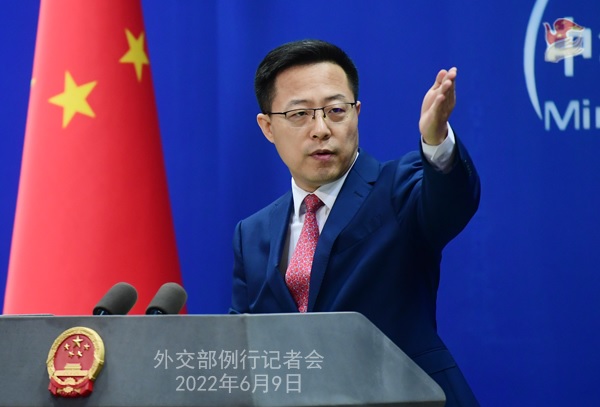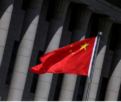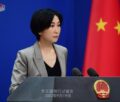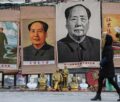China Foreign Ministry Presser on June 9, 2022

China Foreign Ministry Spokesperson held a regular presser on June 9, and fielded questions on a host of topics that range from C+C5 meeting to Iran Nuclear issue, and from Child Labour to China visas for Indian students.

Excerpts
CCTV: From June 6 to 8, State Councilor and Foreign Minister Wang Yi visited Kazakhstan at invitation and attended the third China+Central Asia (C+C5) Foreign Ministers’ Meeting. This is the first time that the C+C5 foreign ministers’ meeting is held in a Central Asian country. Can you share the important outcomes of this visit?
Zhao Lijian: The visit by State Councilor and Foreign Minister Wang Yi was fully packed, fruitful and full of significance.?
During the visit in Kazakhstan, State Councilor and Foreign Minister Wang Yi met with President Kassym-Jomart Tokayev of Kazakhstan and held talks with Deputy Prime Minister and Foreign Minister Mukhtar Tileuberdi. The two sides agreed that standing at a new historical starting point, the two countries should continue to carry forward traditional friendship, deepen practical cooperation, and forge the next golden three decades of China-Kazakhstan relations in line with the principles of good-neighborliness, mutual respect, equality, mutual trust, mutual benefit and win-win cooperation. ……. The Kazakh side said that it would extend the visa-free period for Chinese citizens from 72 hours to 14 days.
At the C+C5 foreign ministers’ meeting, State Councilor and Foreign Minister Wang Yi and all participating parties focused on implementing the outcomes of the Virtual Summit to Commemorate the 30th Anniversary of Diplomatic Relations Between China and Central Asian Countries and put forward five proposals on building an even closer China-Central Asia community with a shared future: improving the mechanisms for the cooperation of the six countries, forging robust engines driving post-COVID recovery, building a strong fortress for regional peace, opening diversified pathways of people-to-people and cultural exchanges, and pooling the positive energy of global governance. The most important outcome is the unanimous agreement to establish the heads of state meeting mechanism of China+Central Asia (C+C5). The six countries will hold biennial summits to make top-level design and provide?strategic steering for their cooperation. The C+C5 foreign ministers’ meeting also adopted four outcome documents, including the Joint Statement on China+Central Asia (C+C5) Foreign Ministers’ Meeting, the Roadmap for the Implementation of the Consensus Reached at the Virtual Summit between China and Central Asian Countries, the Initiative on Deepening China+Central Asia (C+C5) Connectivity Cooperation, and the Data Security Cooperation Initiative of China+Central Asia (C+C5)…….
I want to stress that China and the five Central Asian countries are connected by mountains and rivers, share common security interests and have complementary economic advantages. We are a community with a shared future with common visions and aspirations. Looking ahead, China is ready to work with Central Asian countries to capitalize on the upgrading of the C+C5 mechanism to deepen political mutual trust and mutually beneficial cooperation and jointly build an even closer China-Central Asia community with a shared future, so as to deliver greater benefits to our six countries and peoples.?
MASTV: The Board?of?Governance?of?the?International Atomic Energy Agency (IAEA)?on June 8 local time adopted a resolution on safeguards in Iran. The motion brought by the United States, Britain, France and Germany was voted against by China and Russia. What’s?your?comment??Could you brief us on China’s position?
Zhao Lijian: China opposes relevant countries’ pushing the IAEA Board of Governors to adopt a resolution to pressure Iran, because pressuring does not help solve problems. It only increases tension, undercuts diplomatic efforts and escalates the situation. The talks on resuming compliance with the JCPOA are currently at a crucial juncture towards conclusion. Being confrontational at the IAEA Board of Governors will only undermine the agency’s cooperation with Iran and disrupt the negotiation process.
China supports the IAEA and Iran in resolving their differences on the safeguards issues through dialogue and cooperation. The pressing task at the moment is to facilitate a successful conclusion of the negotiations and bring the JCPOA back to the right track, which will make it much easier to find the solutions needed for resolving the safeguards issues. Since the US started the Iranian nuclear crisis, it has the obligation to fully correct its mistakes, actively respond to Iran’s legitimate concerns and work toward an early conclusion of the talks on resuming compliance. All relevant parties need to create the necessary conditions and a favourable environment for diplomatic?efforts.? ??
Shenzhen TV: June 12, or the upcoming Sunday, marks the World Day Against Child Labor established by the International Labor Organization (ILO). We have noted that the United Nations General Assembly plans to end all forms of child labor by 2025. However, the use of child labor remains prevalent in the US. Do you have any comment?
Zhao Lijian: Children are the hope and future of the world. It is the shared consensus of countries to respect and protect children’s rights and keep them away from heavy work. However, the US, the most developed country in the world, has been repeatedly criticized by ILO for its child labor problem.?
Like slave trade and racial discrimination, the child labor issue in the US dates back to more than a century ago, when child laborers were hired and exploited down mine shafts, on tobacco farms and in textile factories. The issue remains unresolved today. According to statistics, children account for half of the 100,000 people trafficked into the US for forced labor each year. According to official US statistics, in 2019, US law enforcement officers found 858 cases of child labor in violation of the Fair Labor Standards Act, with a total of 544 minors employed in violation of Hazardous Occupation Orders. In October 2021, Wisconsin even passed a bill that allows extended work hours for 14-year-olds.
The plight of US child laborers working in the agriculture sector is particularly concerning. Estimates by the Association of Farmworker Opportunity Programs suggest that there are approximately 500,000 child farmworkers in the US. Many of these children started working when they were only eight, and 72-hour work weeks (more than 10 hours per day) are not uncommon. They are regularly exposed to pesticide and other hazardous chemical substances. Children are three times more susceptible to the pesticides’ carcinogenic effects than adults. They have to handle dangerous sharp-edged tools and heavy machinery without adequate training or protective measures to ensure their health and safety. According to The Washington Post, between 2003 and 2016 alone, a total of 452 child occupational deaths were registered across the US, of which more than half, or 237, were due to farm-related work accidents. Besides, tobacco farms in many US states employ a large number of children to harvest and dry tobacco leaves. Working on tobacco farms can do great harm to children’s physical and mental health, as many have reportedly experienced symptoms of nicotine poisoning and some have even suffered lung infection.
The miseries of US child laborers are only the tip of the iceberg of the US’s systemic human rights violations. The US needs to face squarely and earnestly address the infringement on child laborers’ rights at home, ratify the United Nations Convention on the Rights of the Child as soon as possible, and properly protect American children’s lawful rights and interests.
Prasar Bharati: According to some messages circulating in few WeChat groups, few Indians got telephonic confirmation from Embassy of China in India that Chinese embassy will start accepting visa applications from 10th of this month. This has created anxiety among Indians who are waiting for Chinese visas. The?Indian side also submitted to the?Chinese side last month the list of Indian students who are waiting to return to China and other Indian families are also waiting for family reunions. Can you please confirm by when China is going to start accepting visa applications of Indians, both students as announced by China and also for non-students, whose families are waiting for their return??
Zhao Lijian: Thanks for your interest in Indian students’ return to China. I have answered relevant questions many times from journalists like you and your Indian colleagues. I can tell you that since the start of the pandemic, China has been facilitating the return to China of foreigners,?including?foreign?students,?who need to come to China while ensuring such return is COVID-secure. We have also been updating relevant visa and other policies in light of the situation.?
As to your question, I would refer you and your colleagues to the Chinese Embassy in India.
Prasar Bharati: I’ll try to ask from Chinese embassy in Delhi, but they must have consulted with Chinese foreign ministry for such kind of decision to be taken. So can you confirm or deny the reports that Chinese embassy in Delhi is going to start accepting visa applications of Indians from tomorrow?
Zhao Lijian: I have made my point clear. Your question is very specific. I would refer you to the Chinese Embassy in India.
Prasar Bharati: Yesterday, New Delhi, US Army’s Pacific Commanding General Charles A. Flynn said that the Chinese activity level at the border with India is eye-opening. Some of the infrastructure being created by China near the border with India is alarming and questioned China’s intentions about it. He also said, the talks that are going on between India and China are helpful. “However, the way China is acting and behaving by the way of build-up is concerning.” Do you have any response or comment on it??
Zhao Lijian: As a journalist from India, you know well the situation in the China-India border region. At present, the China-India border situation is stable in general. The front-line armies of the two countries have realized disengagement in most parts of the Western sector of the China-India border. The China-India boundary question is a matter between the two countries. Both sides have the will and capability of resolving the question through dialogue and consultation. Some US officials have pointed fingers and sought to fan the flame and drive a wedge between the two countries. This is disgraceful. We hope the US could do more things that contribute to regional peace and stability.
https://www.mfa.gov.cn/eng/xwfw_665399/s2510_665401/202206/t20220609_10701010.html
-
Book Shelf
-
 Book Review
DESTINY OF A DYSFUNCTIONAL NUCLEAR STATE
Book Review
DESTINY OF A DYSFUNCTIONAL NUCLEAR STATE
- Book ReviewChina FO Presser Where is the fountainhead of jihad?
- Book ReviewNews Pak Syndrome bedevils Indo-Bangla ties
- Book Review Understanding Vedic Equality….: Book Review
- Book Review Buddhism Made Easy: Book Review
- Book ReviewNews Elegant Summary Of Krishnamurti’s teachings
- Book Review Review: Perspectives: The Timeless Way of Wisdom
- Book ReviewNews Rituals too a world of Rhythm
- Book Review Marx After Marxism
- Book Review John Updike’s Terrorist – a review
-
-
Recent Top Post
-
 NewsTop Story
What Would “Total Victory” Mean in Gaza?
NewsTop Story
What Would “Total Victory” Mean in Gaza?
-
 CommentariesTop Story
The Occupation of Territory in War
CommentariesTop Story
The Occupation of Territory in War
-
 CommentariesTop Story
Pakistan: Infighting in ruling elite intensifies following shock election result
CommentariesTop Story
Pakistan: Infighting in ruling elite intensifies following shock election result
-
 CommentariesTop Story
Proforma Polls in Pakistan Today
CommentariesTop Story
Proforma Polls in Pakistan Today
-
 CommentariesTop Story
Global South Dithering Away from BRI
CommentariesTop Story
Global South Dithering Away from BRI
-
 News
Meherabad beckons….
News
Meherabad beckons….
-
 CommentariesTop Story
Hong Kong court liquidates failed Chinese property giant
CommentariesTop Story
Hong Kong court liquidates failed Chinese property giant
-
 CommentariesTop Story
China’s stock market fall sounds alarm bells
CommentariesTop Story
China’s stock market fall sounds alarm bells
-
 Commentaries
Middle East: Opportunity for the US
Commentaries
Middle East: Opportunity for the US
-
 Commentaries
India – Maldives Relations Nosedive
Commentaries
India – Maldives Relations Nosedive
-
AdSense code



















